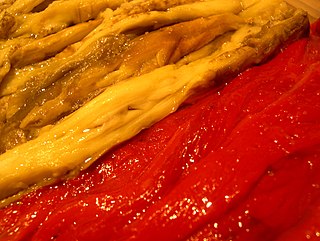
Gazpacho or gaspacho, also called Andalusian gazpacho, is a cold soup and drink made of raw, blended vegetables. It originated in the southern regions of the Iberian Peninsula and spread into other areas. Gazpacho is widely eaten in Spain and Portugal, particularly during hot summers, since it is refreshing and cool.

Turkish cuisine is the cuisine of Turkey and the Turkish diaspora. Although the cuisine took its current rich form after numerous cultural interactions throughout centuries, it should not be confused with other cuisines such as Ottoman cuisine or Seljuk cuisine. Turkish cuisine with traditional Turkic elements such as yogurt, ayran, kaymak, exerts and gains many influences to and from Greek, Armenian, Mediterranean, Balkan, Middle Eastern, Central Asian and Eastern European cuisines.

Tzatziki, also known as cacık or tarator, is a class of dip, soup, or sauce found in the cuisines of Southeastern Europe and West Asia. It is made of salted strained yogurt or diluted yogurt mixed with cucumbers, garlic, salt, olive oil, red wine vinegar, sometimes with lemon juice, and herbs such as dill, mint, parsley and thyme. It is served as a cold appetiser (meze), a side dish, and as a sauce for souvlaki and gyros sandwiches and other foods.

Ceviche, cebiche, sebiche, or seviche is a dish consisting of fish or shellfish marinated in citrus and seasonings, and is recognized by UNESCO as an expression of Peruvian traditional cuisine and Intangible Cultural Heritage of Humanity. Different versions of ceviche are part of the culinary culture of various Spanish-American countries along the Pacific Ocean where each one is native: Chile, Colombia, Costa Rica, Ecuador, El Salvador, Guatemala, Honduras, Mexico, Nicaragua, Panama and Peru. In Peru it is also considered a flagship dish and cultural heritage.

Escalivada, also sometimes transcribed in French as 'escalibade' and in Spanish as escalibada, is a traditional dish from Roussillon, Catalonia, València, Murcia and Aragón of smoky grilled vegetables. It typically consists of roasted eggplant and bell peppers with olive oil and sometimes onion, tomato, minced garlic, and salt.

Green sauce or greensauce is a family of cold, uncooked sauces based on chopped herbs, including the Spanish and Italian salsa verde, the French sauce verte, the German grüne Soße or Frankfurter grie Soß, the British mint sauce and greensauce, and the Argentinian chimichurri.
Romanian cuisine is a diverse blend of different dishes from several traditions with which it has come into contact, but it also maintains its own character. It has been influenced mainly by Turkish but also a series of European cuisines in particular from the Balkan Peninsula and Hungarian cuisine as well as culinary elements stemming from the cuisines of Central Europe.

Pickling is the process of preserving or extending the shelf life of food by either anaerobic fermentation in brine or immersion in vinegar. The pickling procedure typically affects the food's texture and flavor. The resulting food is called a pickle, or, if named, the name is prefaced with the word "pickled". Foods that are pickled include vegetables, fruits, mushrooms, meats, fish, dairy and eggs.

Cypriot cuisine is the cuisine of the island of Cyprus, shared by both Greek Cypriots and Turkish Cypriots.

Pescado frito, also called pescaíto frito, is a traditional dish from the Southern coast of Spain, typically found in Andalusia, but also in Catalonia, Valencia, the Canary Islands and the Balearic Islands.
Chireta is an Aragonese type of savoury pudding. It is a flavorful rustic dish typical to the counties of Ribagorza, Sobrarbe and Somontano de Barbastro, high up in the Spanish Pyrenees. In the Catalan counties of Alta Ribagorça and Pallars, formerly territories united to the historic County of Ribagorza in medieval Aragon, chireta is known as gireta, or girella, respectively.

Many cuisines feature eggplant salads and appetizers.

The bocadillo or bocata, in Spain, is a sandwich made with Spanish bread, usually a baguette or similar type of bread, cut lengthwise. Traditionally seen as a humble food, its low cost has allowed it to evolve over time into an iconic piece of cuisine. In Spain, they are often eaten in cafes and tapas bars.

Venetian cuisine, from the city of Venice, Italy, or more widely from the region of Veneto, has a centuries-long history and differs significantly from other cuisines of northern Italy, and of neighbouring Austria and of Slavic countries, despite sharing some commonalities.

Cappon magro is an elaborate Genoese salad of seafood and vegetables over hardtack arranged into a decorative pyramid and dressed with a rich sauce.

Anchovies are small, common saltwater forage fish in the family Engraulidae that are used as human food and fish bait. There are 144 species in 17 genera found in the Atlantic, Indian, and Pacific Oceans. Anchovies are usually classified as oily fish. They are small, green fish with blue reflections due to a silver longitudinal stripe that runs from the base of the caudal fin. They range from 2 centimetres (0.79 in) to 40 centimetres (16 in) in adult length, and the body shape is variable, with more slender fish in northern populations.

The traditional cuisine of Abruzzo is eclectic, drawing on pastoral, mountain, and coastal cuisine. Staples of Abruzzo cuisine include bread, pasta, meat, fish, cheese, and wine. The isolation which has characterized the region for centuries has ensured the independence of its culinary tradition from those of nearby regions. Local cuisine was widely appreciated in a 2013 survey among foreign tourists.















